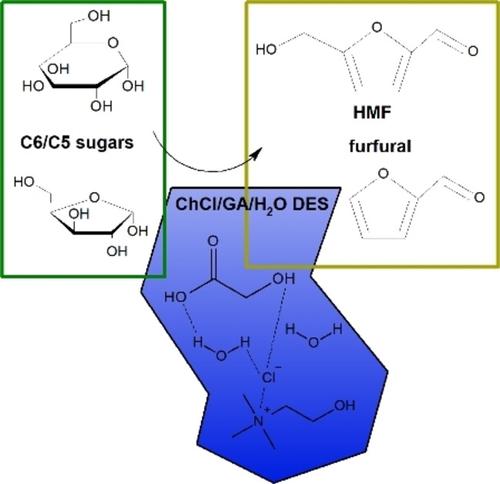当前位置:
X-MOL 学术
›
Chemistryopen
›
论文详情
Our official English website, www.x-mol.net, welcomes your
feedback! (Note: you will need to create a separate account there.)
Furfural and 5-Hydroxymethylfurfural Production from Sugar Mixture Using Deep Eutectic Solvent/MIBK System
ChemistryOpen ( IF 2.5 ) Pub Date : 2021-10-07 , DOI: 10.1002/open.202100163
Annu Rusanen 1 , Katja Lappalainen 1 , Johanna Kärkkäinen 1 , Ulla Lassi 1
ChemistryOpen ( IF 2.5 ) Pub Date : 2021-10-07 , DOI: 10.1002/open.202100163
Annu Rusanen 1 , Katja Lappalainen 1 , Johanna Kärkkäinen 1 , Ulla Lassi 1
Affiliation

|
Choline chloride (ChCl) / glycolic acid (GA) deep eutectic solvent (DES) media with high water content but without any additional catalyst are introduced in furfural and 5-hydroxymethylfurfural (HMF) production. The effects of water content, reaction time, and reaction temperature are investigated with two feedstocks: a glucose/xylose mixture and birch sawdust. Based on the results, 10 equivalent quantities of water (32.9 wt.%) were revealed to be beneficial for conversions without rupturing the DES structure. The optimal reaction conditions were 160 °C and 10 minutes for the sugar mixture and 170 °C and 10 minutes for birch sawdust in a microwave reactor. High furfural yields were achieved, namely 62 % from the sugar mixture and 37.5 % from birch sawdust. HMF yields were low, but since the characterization of the solid residue of sawdust, after DES treatment, was revealed to contain only cellulose (49 %) and lignin (52 %), the treatment could be potentially utilized in a biorefinery concept where the main products are obtained from the cellulose fraction. Extraction of products into the organic phase (methyl isobutyl ketone, MIBK) during the reaction enabled the recycling of the DES phase, and yields remained high for three runs of recycling.
中文翻译:

使用低共熔溶剂/MIBK 系统从糖混合物生产糠醛和 5-羟甲基糠醛
糠醛和 5-羟甲基糠醛 (HMF) 生产中引入了氯化胆碱 (ChCl)/乙醇酸 (GA) 低共熔溶剂 (DES) 介质,其含水量高,但不添加任何催化剂。使用两种原料研究了水含量、反应时间和反应温度的影响:葡萄糖/木糖混合物和桦木锯末。根据结果,10 当量的水 (32.9 wt.%) 被证明有利于转化而不破坏 DES 结构。在微波反应器中,糖混合物的最佳反应条件为 160 °C 10 分钟,桦木锯末的最佳反应条件为 170 °C 10 分钟。糠醛的收率很高,即来自糖混合物的糠醛收率为 62%,来自桦木锯末的糠醛收率为 37.5%。 HMF 产量较低,但由于经过 DES 处理后,锯末固体残留物的特征显示仅含有纤维素 (49%) 和木质素 (52%),因此该处理可潜在地用于生物精炼概念,其中主要产品是从纤维素部分获得的。反应过程中将产物萃取到有机相(甲基异丁基酮,MIBK)中,实现了 DES 相的回收,并且在三轮回收中产率仍然很高。
更新日期:2021-10-07
中文翻译:

使用低共熔溶剂/MIBK 系统从糖混合物生产糠醛和 5-羟甲基糠醛
糠醛和 5-羟甲基糠醛 (HMF) 生产中引入了氯化胆碱 (ChCl)/乙醇酸 (GA) 低共熔溶剂 (DES) 介质,其含水量高,但不添加任何催化剂。使用两种原料研究了水含量、反应时间和反应温度的影响:葡萄糖/木糖混合物和桦木锯末。根据结果,10 当量的水 (32.9 wt.%) 被证明有利于转化而不破坏 DES 结构。在微波反应器中,糖混合物的最佳反应条件为 160 °C 10 分钟,桦木锯末的最佳反应条件为 170 °C 10 分钟。糠醛的收率很高,即来自糖混合物的糠醛收率为 62%,来自桦木锯末的糠醛收率为 37.5%。 HMF 产量较低,但由于经过 DES 处理后,锯末固体残留物的特征显示仅含有纤维素 (49%) 和木质素 (52%),因此该处理可潜在地用于生物精炼概念,其中主要产品是从纤维素部分获得的。反应过程中将产物萃取到有机相(甲基异丁基酮,MIBK)中,实现了 DES 相的回收,并且在三轮回收中产率仍然很高。

































 京公网安备 11010802027423号
京公网安备 11010802027423号